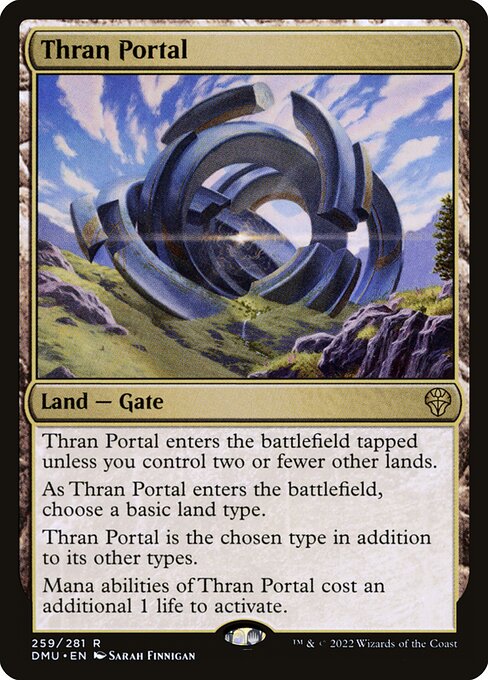
Top Performing Decklists
| Deck | Creator | Record | Best Finish |
|---|
Performance Stats (Last 14 Days)
Win Rate Impact
Top Table Win Rate
Meta Trend
Sample Size
Tournament Results
Average Copies
Archetypes Using This Card:
Bant Auras , Boros Aggro , Boros Auras , Boros Burn , Boros Convoke , Boros Mice , DImir Tempo , Domain Zur Overlords , Esper Oculus , Golgari Demons
Meta Performance Analysis
Thran Portal ranks #407 out of approximately 406 cards in raw efficiency (top 100%).
Game Impact Factor
Color Differential
Colorless average: 63.4%
Performance compared to other Colorless cardsBased on our comprehensive multi-metric analysis, Thran Portal is an underperforming card in the current meta.
Recommended number of copies: 1
Win Rate Timeline
Card Efficiency Analysis
Raw Efficiency (Win Rate/Mana)
Relative Efficiency
Performance Efficiency: 100.00 (Win rate × Top 8 rate ÷ Mana value)
At 0 mana, the average win rate in the format is 74.4%. Thran Portal has a win rate of 100.0%, making it 34.4% better than other 0-mana cards.
Top Performing Partners
| Card Name | Type | Deck Count | Win Rate | 1st Places |
|---|---|---|---|---|
| Giant Growth | Instant | 5 | 92.0% | 4 |
| Pawpatch Recruit | Creature — Rabbit Warrior | 11 | 63.8% | 6 |
| Mabel, Heir to Cragflame | Legendary Creature — Mouse Soldier | 6 | 61.3% | 1 |
| Fugitive Codebreaker | Creature — Goblin Rogue | 30 | 60.2% | 11 |
| Leyline of Resonance | Enchantment | 9 | 59.6% | 4 |
| Obstinate Baloth | Creature — Beast | 9 | 56.7% | 6 |
| Snakeskin Veil | Instant | 13 | 56.4% | 6 |
| Knight-Errant of Eos | Creature — Human Knight | 6 | 55.6% | 2 |
| Feather of Flight | Enchantment — Aura | 9 | 55.1% | 4 |
| Cacophony Scamp | Creature — Phyrexian Goblin Warrior | 12 | 53.0% | 5 |
Card Synergy Analysis
Cards that perform better with Thran Portal than they do on average. A positive synergy score indicates stronger performance together.
| Card Name | Type | Mana | Decks | Win Rate Together | Win Rate Apart | Synergy Score |
|---|
Top Archetypes
| Archetype | Deck Count | % of Archetype | Win Rate |
|---|---|---|---|
| Boros Burn | 100 | 25.5% | 41.6% |
| Boros Auras | 13 | 19.7% | 42.4% |
| Red Deck Wins | 13 | 0.9% | 26.4% |
| Gruul Aggro | 10 | 0.5% | 17.7% |
| Unclassified | 7 | 3.5% | 11.2% |
Statistics Explanation
| Statistic | Description | Formula |
|---|---|---|
| Win Rate Impact | How much this card increases or decreases the win rate of decks that include it, compared to the average deck in the format. | (Win rate of decks with this card) - (Average win rate of all decks) |
| Top Table Win Rate | A weighted win rate that gives more significance to performance in higher tournament placements. First place finishes count for 2x, with diminishing weight down to 8th place. | ∑(wins × placement_weight) / ∑((wins + losses) × placement_weight) |
| Meta Trend | Shows if the card is performing better or worse in the most recent period compared to earlier periods. Positive values indicate improving performance. | (Win rate in recent half of time period) - (Win rate in earlier half of time period) |
| Confidence Factor | A measure of statistical reliability based on sample size. The progress bar indicates how confident we are in the statistics (with larger sample sizes providing higher confidence). | log10(Number of decks + 1) |
| Average Copies | The average number of copies of this card included in decks that use it. | ∑(Copies in each deck) / (Number of decks) |
| Card Synergy Score | Measures how well this card performs with other cards compared to their individual performance. | (Win rate together) - (Average of individual win rates) |
| Raw Efficiency | Win rate points per mana invested. Higher values indicate better returns on mana investment. | (Win rate) / (Mana value) |
| Relative Efficiency | How efficient this card is compared to the average card of the same mana value. | ((Win rate) / (Format average win rate for same mana)) / (Mana value) |
| Performance Efficiency | Combined metric that accounts for win rate, tournament success, and mana investment. | (Win rate × Top 8 placement rate) / (Mana value) |
| Game Impact Factor | A measure of how much this card affects game outcomes, based on win rate adjusted by its deviation from the format average. | Win rate × (1 + (Win rate - Format average) / 100) |
| Color Differential | How this card's win rate compares to the average win rate of other cards of the same color. | Win rate - Average win rate for same color |
All statistics are calculated using tournament data from the selected time period. Sample sizes below 10 decks may not provide statistically significant results.